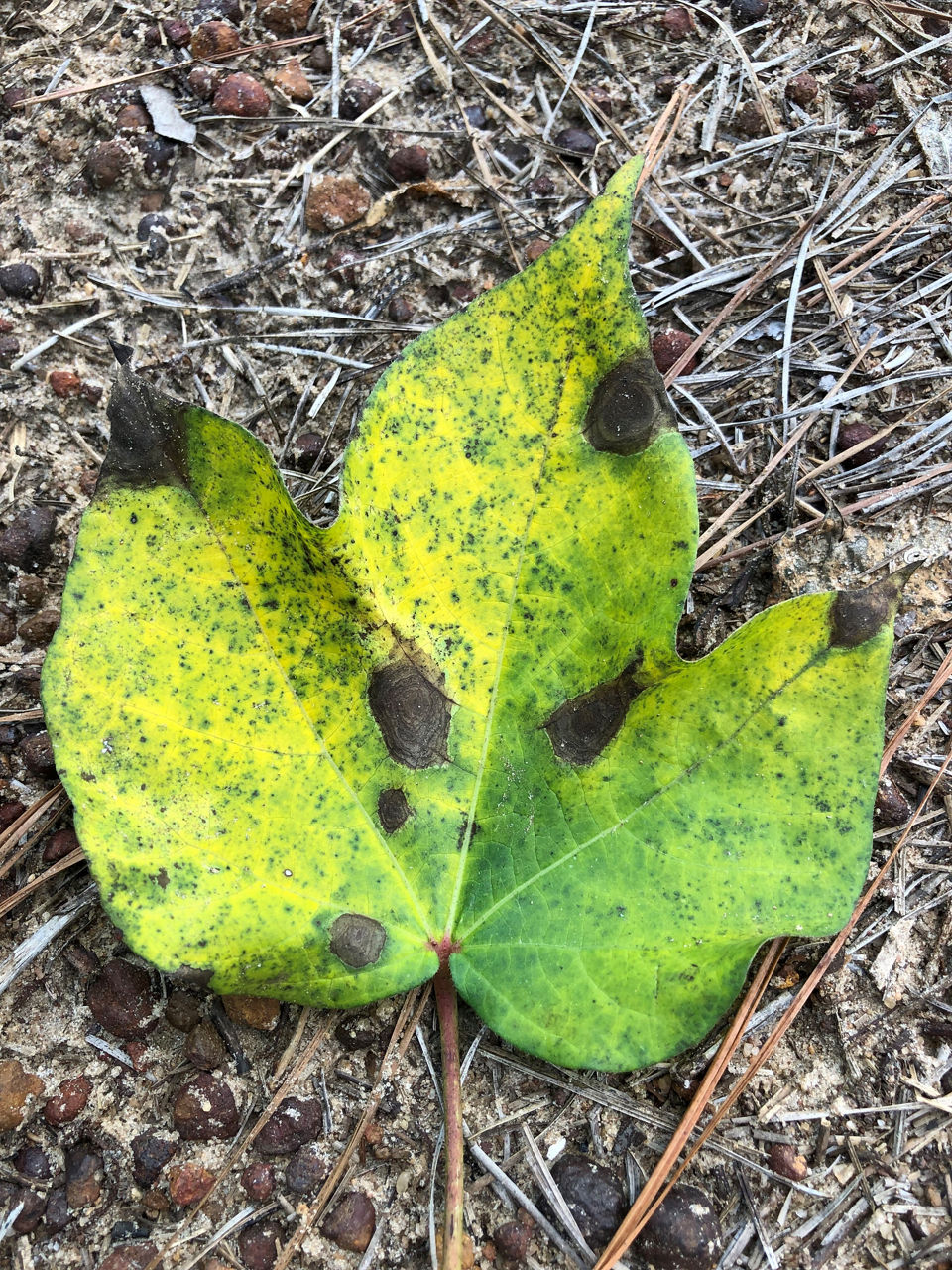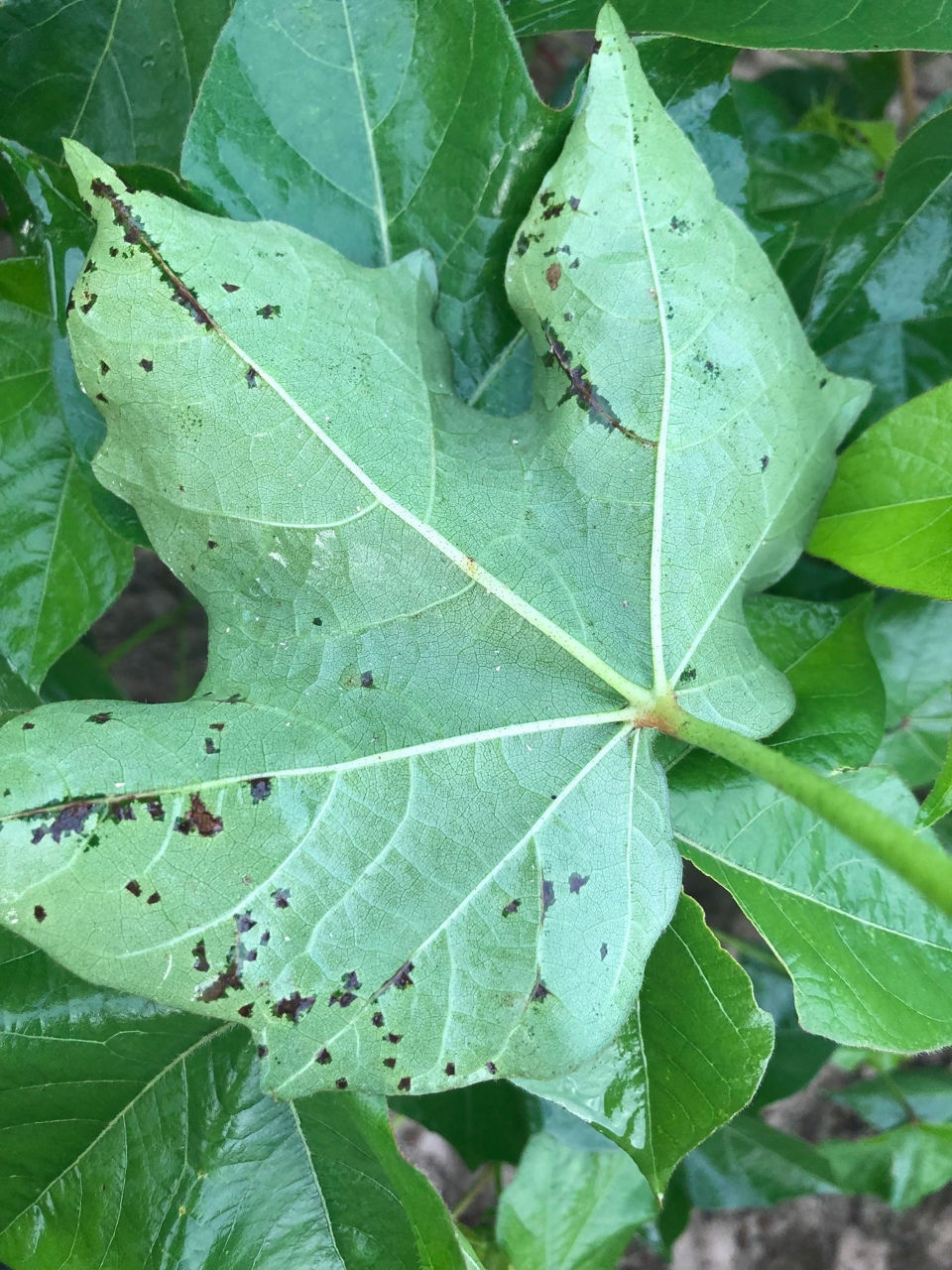3 MIN READ
Managing Cotton Diseases
September 18, 2024
Introduction
The potential for cotton diseases to develop across the Cotton Belt occurs annually due to the presence of pathogens, crop susceptibility, and the seasonal return of favorable growing conditions for disease development. Together, these three components form the disease triangle. Being aware of historical diseases in their growing area can help growers make proactive disease management decisions.
Indeed, growers can use many factors to help manage disease spread and intensity, including previous and current crop scouting records, cotton variety selection, crop rotation, seed treatments, foliar and soil-applied fungicides, insect and weed management, seeding rates, nematicides, and soil fertility, among others. Knowing the causal agent for a disease is also helpful, because management practices are different for fungal, bacterial, or viral diseases. Fungicides only manage diseases caused by fungal pathogens, and insect management can limit the vectors for viral diseases. Nematodes are another potential causal agent of cotton disease. Note that while nematodes are not diseases but are actually microscopic worms, they are often treated as pathogenic diseases because the visual symptoms of their attacks can mimic plant diseases.
Disease Management Considerations
Overall Plant Health
Maintaining adequate soil fertility levels for cotton production via soil test results helps plants develop healthy systems for carbohydrate, nutrient, and water transfer. Potassium is known to help reduce the incidence and severity of wilt diseases.1 Soil insect and nematode management helps maintain plant health by reducing the potential for root injury, which might otherwise reduce a plant’s ability to absorb nutrients and water. Damaged roots can also be entry points for pathogens.
Crop Rotation
Since some diseases are specific to cotton, establishing a long-term crop rotation can help create an overall balance for crop health and disease management. The planting of non-host crops can help interrupt pathogen lifecycles by reducing pathogen inoculums. Additionally, crop rotations can help manage soil insect and nematode populations, weed populations, and the nutrient drains of specific crops—such as the high calcium requirement of peanuts, for example. Cotton farmers should consider setting aside a percentage of their cotton acreage to take advantage of market prices; however, long-term rotations can help lower costs associated with pesticide applications.2 Table 1 provides general rotational crop ratings to help manage cotton diseases.
Table 1. Rotational crops for cotton for reducing the incidence fo cotton diseases.

Plant Growth Regulators (PGR)
Understanding the growth habit of a cotton variety is important for managing vegetative growth and airflow within the canopy. Some cotton varieties have a more aggressive growth pattern and should be managed aggressively with PGR rates and timing.3 Rank growth is likely to make plants prone to many leaf diseases and boll rot. Preventing rank growth with PGR products can help reduce the spread of disease by lowering humidity and increasing light penetration. Plant growth should be continuously monitored during the growing season as field and growing conditions change.
Variety Selection
Selecting cotton products with high tonnage potential is a key to help profitable production. However, selection priorities should include other varietal characteristics such as plant type, maturity, and tolerance or resistance to diseases such as Fusarium, Verticillium, and bacterial blight. Deltapine® brand cotton product profiles are available here.
Seed Treatments
Seed treatment fungicides may be protectants or systemics. Protectant fungicides help protect the seed from pathogens carried on the seed or soil pathogens in direct contact with the seed. Systemic fungicides are absorbed by the seedling to help provide protection from certain types of pre- and post-emergence damping-off diseases. In-furrow fungicides may be considered for fields with historically high seedling disease pressure, those having poor drainage, or fields that may be planted early (Table 2).4 A review of Acceleron® Solutions Offerings for cotton available from Bayer Crop Science can be found here.
Planting Date
Early season diseases occur more often in wet and poorly drained soil conditions. Therefore, seeding should occur when the soil temperature is above 65 °F at a depth of four inches and the future weather forecast is favorable for five days.5 Raised beds may help increase soil temperature and aid in drainage.
Scouting
In-season disease prevention begins with scouting, starting with seedling emergence.4 Please refer to Identification of Cotton Diseases for additional cotton disease information. Should disease symptoms such as those of target spot (Figure 1) be discovered, and economic injury is a potential, the use of a labeled foliar fungicide may be an option. Should bacterial blight (Figure 2) be present, a bactericidal treatment may be warranted. Table 2 lists four Bayer Crop Science disease protection products for the suppression of labeled diseases.


Table 2. Bayer Crop Science foliar and soil-applied fungicides for cotton diseases.

Residue Management
Stalks should be chopped and, if possible, incorporated to help reduce overwintering disease pathogens and insects. Cotton regrowth can sustain insects like aphids, which can vector viral diseases. Because many weeds and rotational crops for cotton are hosts for cotton diseases, it is important to keep fields weed free and manage rotational crop residues, especially in fields with known disease outbreaks.6
Sources
1Cutts, T. Role of potassium in cotton production. Yara North America. https://www.yara.us/crop-nutrition/cotton/role-of-potassium/
2Thompson, C. 2014. Crop rotation a reliable management strategy for farmers. University of Georgia, CAES Newswire. https://newswire.caes.uga.edu/story/4992/crop-rotation.html
3Raper, T. 2019. And away we go: Controlling cotton plant growth in 2019. University of Tennessee Institute of Agriculture, UTcrops News Blog. https://news.utcrops.com/2019/06/and-away-we-go-controlling-cotton-plant-growth-in-2019/
4Boyd, M.L., Phipps, B.J., and Wrather, J.A. 2004. Cotton pests scouting & management. Integrated Pest Management. IPM1025. Missouri University Extension. University of Missouri-Columbia. https://mospace.umsystem.edu/xmlui/bitstream/handle/10355/7600/CottonPestsScoutingManagement.pdf?sequence=1&isAllowed=y
5Boman, R. and Lemon, R. 2005. Soil temperatures for cotton planting. AgriLIFE Extension, Texas A&M System. Texas A&M University. SCS-2005-17. https://ccag.tamu.edu/wp-content/uploads/sites/10/2020/12/scs-2005-17-Soil-Temp.pdf
6Hake, K., Carter, L., Moore, L., Parker, R., Summy, R., Watson, T., and Williford, R. 1991. Cotton stalk management. Physiology Today, Newsletter of the Cotton Physiology Education Program – National Cotton Council. https://www.cotton.org/tech/physiology/cpt/pest/upload/CPT-Sep91-REPOP.pdf
Additional Resources
Barlow, V.M., Davis, R.M. Godfrey, L.D., et al. 2015. UC IPM pest management guidelines: Cotton. Crop rotation. https://cottoninfo.ucdavis.edu/sites/g/files/dgvnsk14551/files/inline-files/pmgcotton.pdf
Disease management. Cotton rotational tool [Poster]. CottonInfo. Cotton Australia and Cotton Research and Development Corporation (CRDC). https://www.cottoninfo.com.au/cotton-rotation-tool
Web sources verified 08/14/24. 1411_69609